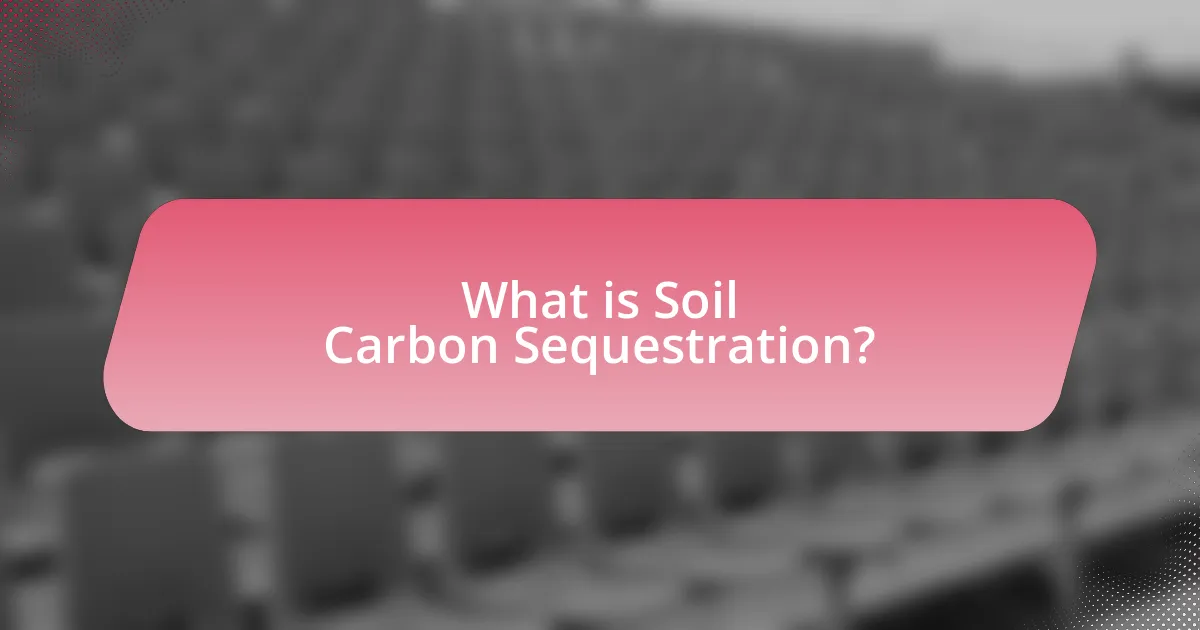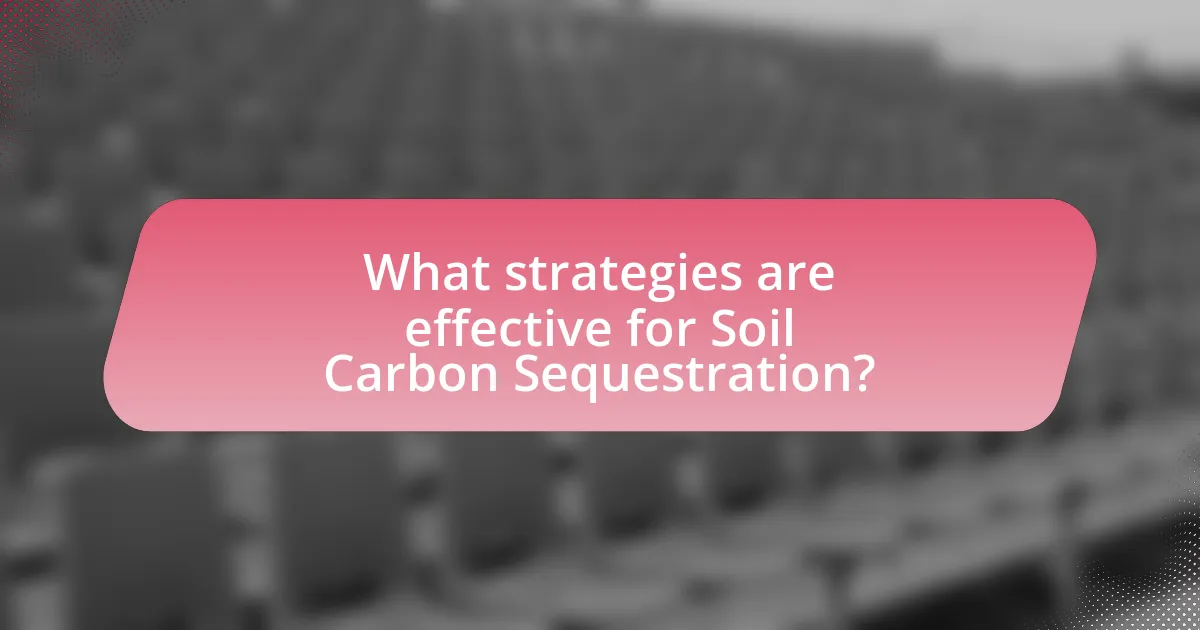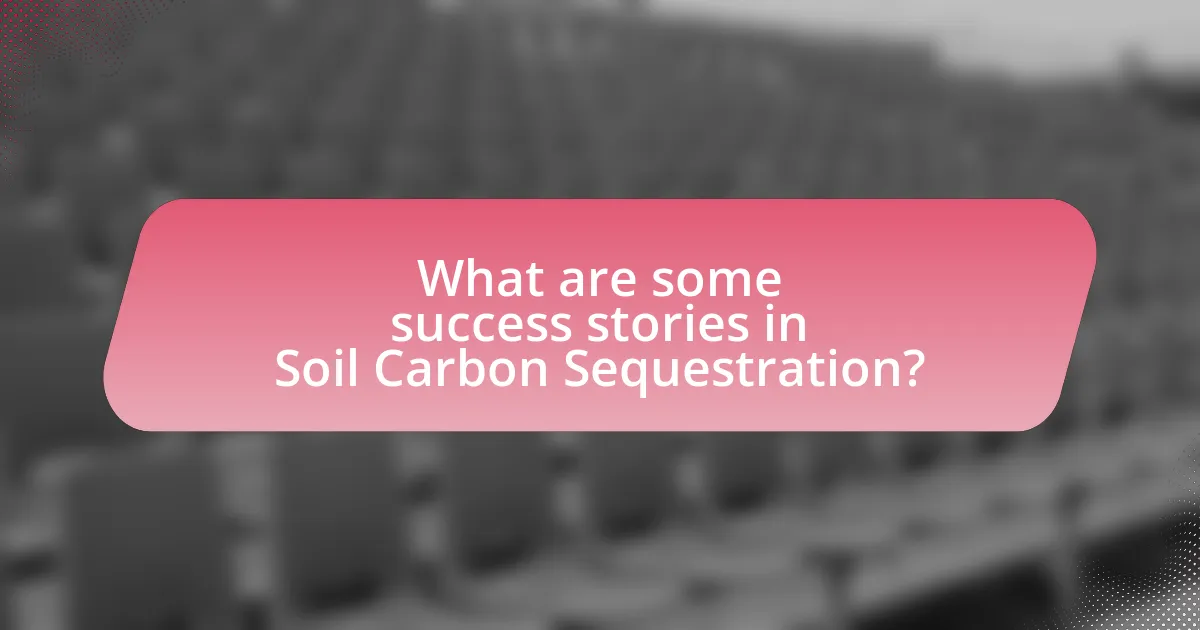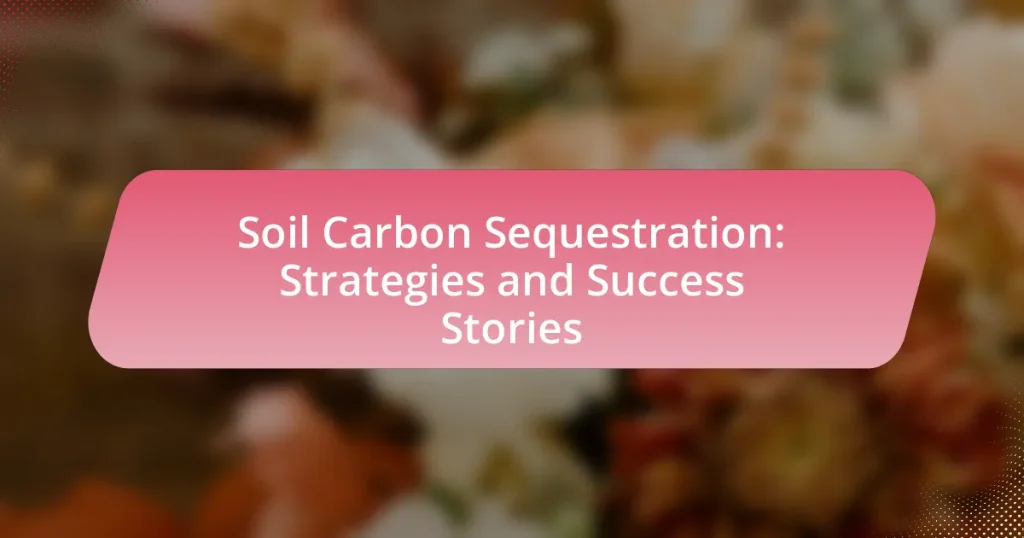Soil carbon sequestration is the process of capturing and storing atmospheric carbon dioxide in the soil, primarily through natural biological processes such as photosynthesis and organic matter decomposition. This article explores the mechanisms of soil carbon sequestration, the influence of soil types, and the importance of this process in mitigating climate change and enhancing agricultural productivity. It outlines effective strategies and agricultural practices, including cover cropping, reduced tillage, and agroforestry, that can significantly increase soil carbon levels. Additionally, the article highlights successful case studies from various regions, discusses challenges faced in implementation, and provides practical tips and resources for farmers interested in adopting carbon sequestration practices.

What is Soil Carbon Sequestration?
Soil carbon sequestration is the process of capturing and storing atmospheric carbon dioxide in the soil. This occurs through natural processes such as photosynthesis, where plants absorb CO2 and convert it into organic matter, which then becomes part of the soil when plants die and decompose. According to the Intergovernmental Panel on Climate Change (IPCC), soil carbon sequestration can significantly mitigate climate change by reducing the amount of CO2 in the atmosphere, with potential increases in soil organic carbon levels of up to 1.1 gigatons per year globally through improved land management practices.
How does Soil Carbon Sequestration work?
Soil carbon sequestration works by capturing and storing atmospheric carbon dioxide (CO2) in the soil through biological processes. Plants absorb CO2 during photosynthesis, converting it into organic matter, which is then transferred to the soil as roots die and decompose. This organic matter enriches the soil, enhancing its carbon content. According to the Intergovernmental Panel on Climate Change (IPCC), soil can store up to three times more carbon than the atmosphere, making it a crucial component in mitigating climate change. Additionally, practices such as cover cropping, reduced tillage, and agroforestry further enhance soil’s ability to sequester carbon by promoting healthy soil ecosystems and increasing organic matter inputs.
What are the key processes involved in Soil Carbon Sequestration?
The key processes involved in soil carbon sequestration include photosynthesis, organic matter decomposition, and soil microbial activity. Photosynthesis captures atmospheric carbon dioxide, converting it into organic compounds that are incorporated into plant biomass. When plants die or shed leaves, organic matter is added to the soil, where it undergoes decomposition by soil microorganisms. This process transforms organic matter into stable forms of carbon, such as humus, which can remain in the soil for extended periods. Additionally, soil microbial activity plays a crucial role in breaking down organic materials and facilitating the formation of stable soil aggregates, further enhancing carbon storage. These processes collectively contribute to the long-term sequestration of carbon in soil, mitigating climate change impacts.
How do soil types influence Carbon Sequestration?
Soil types significantly influence carbon sequestration by affecting the soil’s physical and chemical properties, which determine its capacity to store carbon. For instance, clay-rich soils have a higher cation exchange capacity and can retain more organic matter, leading to increased carbon storage compared to sandy soils, which have lower nutrient retention and organic matter capacity. Research indicates that soils with higher organic carbon content, such as those found in wetlands and peatlands, can sequester up to 30% more carbon than drier, less fertile soils. Additionally, soil texture, structure, and microbial activity vary across soil types, further impacting the rate of carbon sequestration.
Why is Soil Carbon Sequestration important?
Soil carbon sequestration is important because it mitigates climate change by capturing and storing atmospheric carbon dioxide in the soil. This process enhances soil health, increases agricultural productivity, and supports biodiversity. According to the Intergovernmental Panel on Climate Change (IPCC), soil carbon sequestration can potentially offset up to 1.1 gigatons of carbon dioxide emissions annually, making it a crucial strategy in global efforts to reduce greenhouse gas concentrations.
What role does Soil Carbon Sequestration play in climate change mitigation?
Soil carbon sequestration plays a critical role in climate change mitigation by capturing and storing atmospheric carbon dioxide in soil organic matter. This process not only reduces greenhouse gas concentrations in the atmosphere but also enhances soil health and fertility. Research indicates that practices such as cover cropping, reduced tillage, and agroforestry can increase soil carbon stocks significantly, with estimates suggesting that global soil carbon sequestration could offset up to 1.5 billion tons of CO2 annually. This evidence underscores the potential of soil management strategies to contribute effectively to climate change mitigation efforts.
How does Soil Carbon Sequestration benefit agricultural productivity?
Soil carbon sequestration enhances agricultural productivity by improving soil health and fertility. Increased organic carbon in the soil leads to better nutrient retention, enhanced microbial activity, and improved soil structure, which collectively boost crop yields. Research indicates that practices such as cover cropping and reduced tillage can increase soil organic carbon levels, resulting in yield increases of 10-20% in various crops. Additionally, healthier soils are more resilient to drought and extreme weather, further supporting consistent agricultural output.

What strategies are effective for Soil Carbon Sequestration?
Effective strategies for soil carbon sequestration include conservation tillage, cover cropping, agroforestry, and organic amendments. Conservation tillage reduces soil disturbance, which helps maintain soil structure and increases carbon storage; studies show that it can enhance soil organic carbon levels by 20-30% over time. Cover cropping involves planting crops during off-seasons to protect soil and enhance organic matter, leading to increased carbon sequestration; research indicates that cover crops can sequester up to 1.5 tons of carbon per hectare annually. Agroforestry integrates trees into agricultural landscapes, which not only captures carbon but also improves biodiversity and soil health; evidence suggests that agroforestry systems can sequester 10-40% more carbon than conventional farming. Lastly, applying organic amendments, such as compost or manure, enriches soil with organic matter, significantly boosting carbon storage; studies have demonstrated that organic amendments can increase soil carbon stocks by 1-2% per year.
What agricultural practices enhance Soil Carbon Sequestration?
Agricultural practices that enhance soil carbon sequestration include cover cropping, reduced tillage, agroforestry, and organic amendments. Cover cropping increases organic matter and improves soil structure, which can lead to higher carbon storage. Reduced tillage minimizes soil disturbance, preserving soil carbon stocks and enhancing microbial activity. Agroforestry integrates trees into agricultural landscapes, which contributes to carbon storage both above and below ground. Organic amendments, such as compost and manure, add carbon-rich materials to the soil, promoting microbial activity and increasing soil organic carbon levels. Studies have shown that these practices can significantly increase soil carbon levels, with cover crops alone potentially sequestering up to 1.5 tons of carbon per hectare annually.
How does cover cropping contribute to Carbon Sequestration?
Cover cropping contributes to carbon sequestration by enhancing soil organic matter and promoting the growth of biomass that captures atmospheric carbon dioxide. The roots of cover crops, such as legumes and grasses, penetrate the soil, facilitating the formation of stable organic compounds that store carbon. Research indicates that cover cropping can increase soil carbon stocks by 0.1 to 0.5 tons per hectare per year, depending on the crop type and management practices. This process not only reduces greenhouse gas emissions but also improves soil health and fertility, creating a sustainable agricultural system.
What is the impact of reduced tillage on soil carbon levels?
Reduced tillage significantly increases soil carbon levels by minimizing soil disturbance, which helps retain organic matter and enhances carbon sequestration. Studies indicate that reduced tillage can lead to an increase in soil organic carbon by approximately 0.1 to 0.3 tons per hectare per year, depending on soil type and climate conditions. This practice reduces erosion and promotes the accumulation of organic materials, thereby improving soil health and fertility. Research published in “Agriculture, Ecosystems & Environment” by Powlson et al. (2014) supports these findings, demonstrating that reduced tillage contributes to long-term carbon storage in agricultural soils.
What role do land management practices play in Soil Carbon Sequestration?
Land management practices significantly enhance soil carbon sequestration by optimizing soil health and increasing organic matter. Practices such as cover cropping, reduced tillage, and agroforestry improve soil structure and promote microbial activity, which in turn facilitates the accumulation of carbon in the soil. For instance, studies have shown that no-till farming can increase soil organic carbon levels by up to 25% over a decade compared to conventional tillage methods. Additionally, integrating diverse plant species through cover cropping can lead to a 30% increase in soil carbon stocks, as reported in research published in the journal “Agriculture, Ecosystems & Environment.” These practices not only sequester carbon but also enhance soil fertility and resilience against climate change.
How can agroforestry systems improve soil carbon storage?
Agroforestry systems can improve soil carbon storage by integrating trees and shrubs with agricultural crops and livestock, which enhances organic matter input to the soil. The presence of deep-rooted trees increases soil structure and stability, leading to greater carbon sequestration. Research indicates that agroforestry can increase soil organic carbon levels by 30% to 50% compared to conventional farming practices, as demonstrated in studies conducted by the World Agroforestry Centre. These systems also promote biodiversity, which further contributes to soil health and carbon retention through improved microbial activity and nutrient cycling.
What are the benefits of rotational grazing for carbon sequestration?
Rotational grazing enhances carbon sequestration by promoting healthier soil and increasing organic matter. This method allows pastures to recover between grazing periods, leading to improved root growth and soil structure. Research indicates that rotational grazing can increase soil carbon stocks by 20-30% compared to continuous grazing systems, as demonstrated in studies conducted by the USDA Agricultural Research Service. Additionally, healthier soils retain more moisture and nutrients, further supporting plant growth and carbon capture.

What are some success stories in Soil Carbon Sequestration?
Some success stories in soil carbon sequestration include the implementation of regenerative agriculture practices in various regions, which have led to significant increases in soil organic carbon levels. For instance, a study conducted by the Rodale Institute demonstrated that regenerative practices, such as cover cropping and reduced tillage, increased soil carbon by 1.5 to 3.5 tons per acre annually over a five-year period. Additionally, the Savory Institute’s work in Africa has shown that holistic planned grazing can restore degraded grasslands, resulting in carbon sequestration rates of up to 2.5 tons per hectare per year. These examples highlight the effectiveness of specific agricultural practices in enhancing soil carbon storage and mitigating climate change.
Which regions have successfully implemented Soil Carbon Sequestration strategies?
Regions that have successfully implemented Soil Carbon Sequestration strategies include California in the United States, Australia, and various countries in Europe such as France and Germany. California has established programs like the Healthy Soils Initiative, which incentivizes farmers to adopt practices that enhance soil carbon storage. Australia has implemented the Carbon Farming Initiative, allowing landholders to earn carbon credits through soil management practices. In Europe, France’s 4 per 1000 initiative aims to increase soil organic carbon levels, while Germany has integrated soil carbon sequestration into its national climate strategy. These regions demonstrate effective policies and practices that contribute to soil carbon sequestration.
What lessons can be learned from successful projects in North America?
Successful projects in North America demonstrate that integrating sustainable agricultural practices significantly enhances soil carbon sequestration. For instance, the adoption of no-till farming and cover cropping has been shown to increase soil organic carbon levels by up to 1.5 tons per hectare annually, as evidenced by research from the USDA Agricultural Research Service. Additionally, collaboration among farmers, scientists, and policymakers fosters innovation and knowledge sharing, leading to more effective carbon management strategies. These projects highlight the importance of tailored approaches that consider local soil types and climate conditions, ensuring that practices are both effective and sustainable.
How have European countries advanced Soil Carbon Sequestration initiatives?
European countries have advanced Soil Carbon Sequestration initiatives through various policies, research programs, and agricultural practices aimed at enhancing soil health and carbon storage. For instance, the European Union’s Common Agricultural Policy promotes sustainable farming techniques that increase organic matter in soils, thereby boosting carbon sequestration. Additionally, countries like France and Germany have implemented national strategies that include financial incentives for farmers to adopt practices such as cover cropping and reduced tillage, which have been shown to significantly increase soil carbon levels. Research conducted by the European Commission indicates that these initiatives can lead to a potential increase of 0.4 to 1.2 gigatons of carbon dioxide equivalent sequestered annually across Europe, demonstrating the effectiveness of these strategies in combating climate change.
What are the challenges faced in Soil Carbon Sequestration efforts?
Soil carbon sequestration efforts face several significant challenges, including land management practices, economic incentives, and measurement difficulties. Land management practices, such as conventional tillage and monoculture cropping, can lead to soil degradation and reduced carbon storage capacity. Economic incentives are often insufficient to encourage farmers to adopt practices that enhance carbon sequestration, as immediate financial returns may not align with long-term environmental benefits. Additionally, accurately measuring soil carbon levels and changes over time is complex, requiring advanced technologies and methodologies that may not be widely accessible. These challenges hinder the effectiveness and scalability of soil carbon sequestration initiatives.
What barriers do farmers encounter when adopting carbon sequestration practices?
Farmers encounter several barriers when adopting carbon sequestration practices, including financial constraints, lack of knowledge, and insufficient access to technology. Financial constraints often arise from the initial investment required for implementing new practices, which can deter farmers from making changes. Additionally, many farmers lack adequate knowledge about carbon sequestration methods and their benefits, leading to uncertainty and reluctance to adopt these practices. Furthermore, limited access to advanced technology and resources can hinder the effective implementation of carbon sequestration strategies, as farmers may not have the tools necessary to monitor and manage soil carbon levels effectively. These barriers collectively impede the widespread adoption of carbon sequestration practices in agriculture.
How can policy frameworks support Soil Carbon Sequestration?
Policy frameworks can support soil carbon sequestration by establishing regulations and incentives that promote sustainable land management practices. These frameworks can include carbon credit systems, which financially reward farmers for adopting practices that enhance soil carbon storage, such as cover cropping and reduced tillage. For instance, the California Cap-and-Trade Program has successfully incentivized carbon sequestration in agricultural soils, leading to increased adoption of practices that improve soil health and sequester carbon. Additionally, policies can facilitate research funding and technical assistance, enabling farmers to implement effective carbon sequestration strategies.
What practical tips can enhance Soil Carbon Sequestration efforts?
To enhance soil carbon sequestration efforts, implement practices such as cover cropping, reduced tillage, and organic amendments. Cover cropping increases organic matter and improves soil structure, which can lead to a 0.5 to 1.5 tons of carbon per hectare per year, as shown in studies by the USDA. Reduced tillage minimizes soil disturbance, preserving soil carbon stocks and potentially increasing carbon retention by 20-30% over time. Additionally, applying organic amendments like compost or biochar can significantly boost soil carbon levels, with research indicating that biochar can sequester carbon for hundreds to thousands of years. These practices collectively contribute to improved soil health and increased carbon storage capacity.
How can farmers measure and monitor soil carbon levels effectively?
Farmers can measure and monitor soil carbon levels effectively by utilizing soil sampling, remote sensing technologies, and soil carbon models. Soil sampling involves collecting soil cores at various depths and analyzing them in a laboratory to determine carbon content, which provides direct measurements of soil organic carbon levels. Remote sensing technologies, such as satellite imagery and aerial drones, allow farmers to assess soil properties over large areas, enabling them to monitor changes in carbon levels over time. Additionally, soil carbon models, like the RothC model, simulate carbon dynamics based on land management practices and environmental conditions, offering predictions on how different practices impact soil carbon sequestration. These methods collectively provide a comprehensive approach to understanding and managing soil carbon levels, supported by research indicating that accurate monitoring is crucial for effective carbon management strategies.
What resources are available for farmers interested in carbon sequestration?
Farmers interested in carbon sequestration can access various resources, including government programs, educational materials, and financial incentives. The USDA’s Natural Resources Conservation Service (NRCS) offers technical assistance and funding through programs like the Environmental Quality Incentives Program (EQIP), which supports practices that enhance soil carbon storage. Additionally, organizations such as the Carbon Farming Initiative provide guidelines and tools for implementing carbon sequestration practices on farms. Research from the Soil Health Institute indicates that practices like cover cropping and reduced tillage can significantly increase soil organic carbon levels, further validating the effectiveness of these resources.















